Jia Cai
DGSNA: prompt-based Dynamic Generative Scene-based Noise Addition method
Nov 19, 2024



Abstract:This paper addresses the challenges of accurately enumerating and describing scenes and the labor-intensive process required to replicate acoustic environments using non-generative methods. We introduce the prompt-based Dynamic Generative Sce-ne-based Noise Addition method (DGSNA), which innovatively combines the Dynamic Generation of Scene Information (DGSI) with Scene-based Noise Addition for Audio (SNAA). Employing generative chat models structured within the Back-ground-Examples-Task (BET) prompt framework, DGSI com-ponent facilitates the dynamic synthesis of tailored Scene Infor-mation (SI) for specific acoustic environments. Additionally, the SNAA component leverages Room Impulse Response (RIR) fil-ters and Text-To-Audio (TTA) systems to generate realistic, scene-based noise that can be adapted for both indoor and out-door environments. Through comprehensive experiments, the adaptability of DGSNA across different generative chat models was demonstrated. The results, assessed through both objective and subjective evaluations, show that DGSNA provides robust performance in dynamically generating precise SI and effectively enhancing scene-based noise addition capabilities, thus offering significant improvements over traditional methods in acoustic scene simulation. Our implementation and demos are available at https://dgsna.github.io.
Unsupervised Visual Representation Learning by Synchronous Momentum Grouping
Jul 13, 2022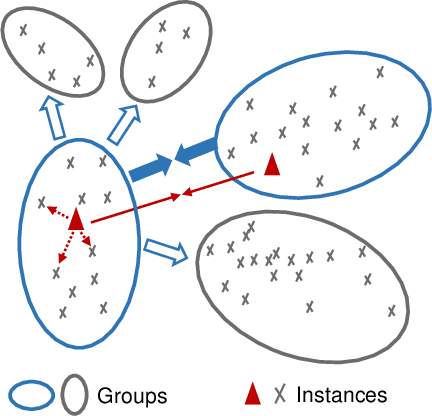
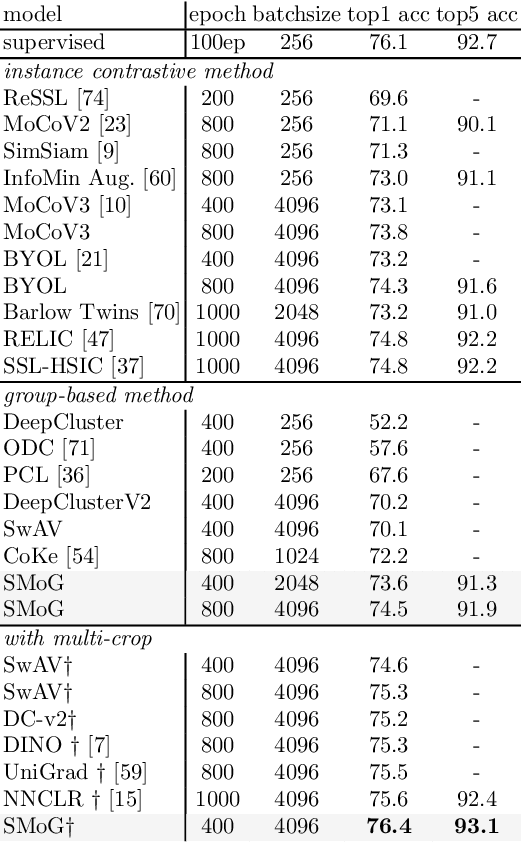
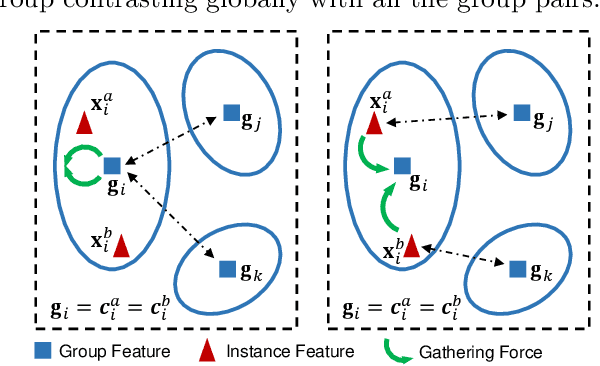
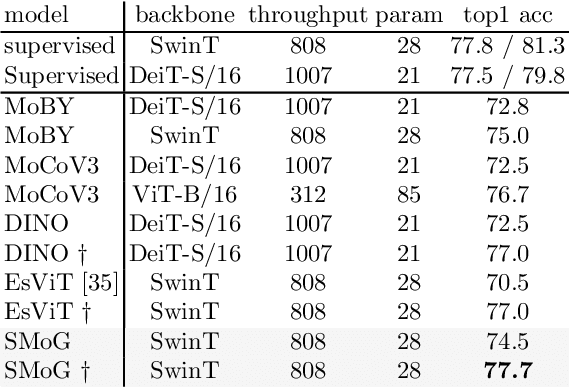
Abstract:In this paper, we propose a genuine group-level contrastive visual representation learning method whose linear evaluation performance on ImageNet surpasses the vanilla supervised learning. Two mainstream unsupervised learning schemes are the instance-level contrastive framework and clustering-based schemes. The former adopts the extremely fine-grained instance-level discrimination whose supervisory signal is not efficient due to the false negatives. Though the latter solves this, they commonly come with some restrictions affecting the performance. To integrate their advantages, we design the SMoG method. SMoG follows the framework of contrastive learning but replaces the contrastive unit from instance to group, mimicking clustering-based methods. To achieve this, we propose the momentum grouping scheme which synchronously conducts feature grouping with representation learning. In this way, SMoG solves the problem of supervisory signal hysteresis which the clustering-based method usually faces, and reduces the false negatives of instance contrastive methods. We conduct exhaustive experiments to show that SMoG works well on both CNN and Transformer backbones. Results prove that SMoG has surpassed the current SOTA unsupervised representation learning methods. Moreover, its linear evaluation results surpass the performances obtained by vanilla supervised learning and the representation can be well transferred to downstream tasks.
WAD-CMSN: Wasserstein Distance based Cross-Modal Semantic Network for Zero-Shot Sketch-Based Image Retrieval
Feb 11, 2022



Abstract:Zero-shot sketch-based image retrieval (ZSSBIR), as a popular studied branch of computer vision, attracts wide attention recently. Unlike sketch-based image retrieval (SBIR), the main aim of ZSSBIR is to retrieve natural images given free hand-drawn sketches that may not appear during training. Previous approaches used semantic aligned sketch-image pairs or utilized memory expensive fusion layer for projecting the visual information to a low dimensional subspace, which ignores the significant heterogeneous cross-domain discrepancy between highly abstract sketch and relevant image. This may yield poor performance in the training phase. To tackle this issue and overcome this drawback, we propose a Wasserstein distance based cross-modal semantic network (WAD-CMSN) for ZSSBIR. Specifically, it first projects the visual information of each branch (sketch, image) to a common low dimensional semantic subspace via Wasserstein distance in an adversarial training manner. Furthermore, identity matching loss is employed to select useful features, which can not only capture complete semantic knowledge, but also alleviate the over-fitting phenomenon caused by the WAD-CMSN model. Experimental results on the challenging Sketchy (Extended) and TU-Berlin (Extended) datasets indicate the effectiveness of the proposed WAD-CMSN model over several competitors.
Multi-scale Graph Convolutional Networks with Self-Attention
Dec 04, 2021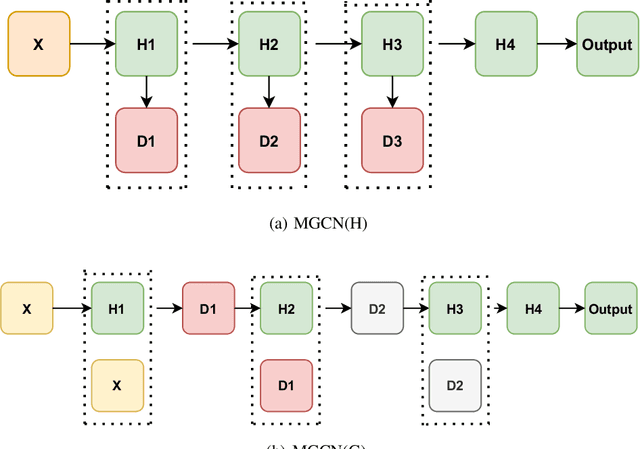


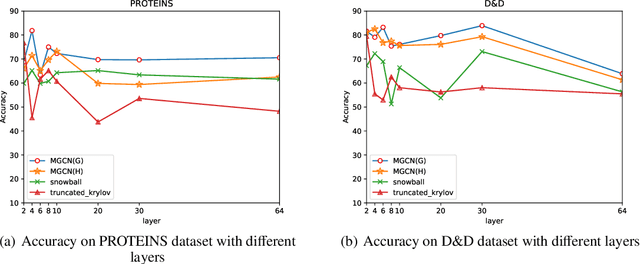
Abstract:Graph convolutional networks (GCNs) have achieved remarkable learning ability for dealing with various graph structural data recently. In general, deep GCNs do not work well since graph convolution in conventional GCNs is a special form of Laplacian smoothing, which makes the representation of different nodes indistinguishable. In the literature, multi-scale information was employed in GCNs to enhance the expressive power of GCNs. However, over-smoothing phenomenon as a crucial issue of GCNs remains to be solved and investigated. In this paper, we propose two novel multi-scale GCN frameworks by incorporating self-attention mechanism and multi-scale information into the design of GCNs. Our methods greatly improve the computational efficiency and prediction accuracy of the GCNs model. Extensive experiments on both node classification and graph classification demonstrate the effectiveness over several state-of-the-art GCNs. Notably, the proposed two architectures can efficiently mitigate the over-smoothing problem of GCNs, and the layer of our model can even be increased to $64$.
SStaGCN: Simplified stacking based graph convolutional networks
Nov 16, 2021

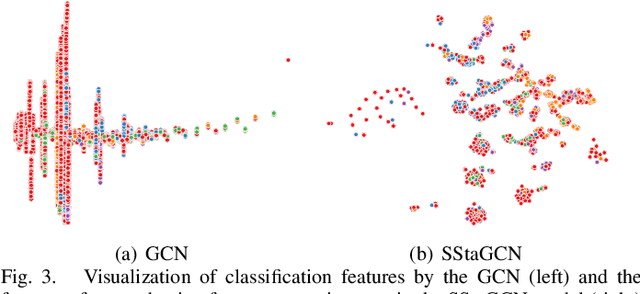

Abstract:Graph convolutional network (GCN) is a powerful model studied broadly in various graph structural data learning tasks. However, to mitigate the over-smoothing phenomenon, and deal with heterogeneous graph structural data, the design of GCN model remains a crucial issue to be investigated. In this paper, we propose a novel GCN called SStaGCN (Simplified stacking based GCN) by utilizing the ideas of stacking and aggregation, which is an adaptive general framework for tackling heterogeneous graph data. Specifically, we first use the base models of stacking to extract the node features of a graph. Subsequently, aggregation methods such as mean, attention and voting techniques are employed to further enhance the ability of node features extraction. Thereafter, the node features are considered as inputs and fed into vanilla GCN model. Furthermore, theoretical generalization bound analysis of the proposed model is explicitly given. Extensive experiments on $3$ public citation networks and another $3$ heterogeneous tabular data demonstrate the effectiveness and efficiency of the proposed approach over state-of-the-art GCNs. Notably, the proposed SStaGCN can efficiently mitigate the over-smoothing problem of GCN.
Sparse Generalized Canonical Correlation Analysis: Distributed Alternating Iteration based Approach
Apr 23, 2020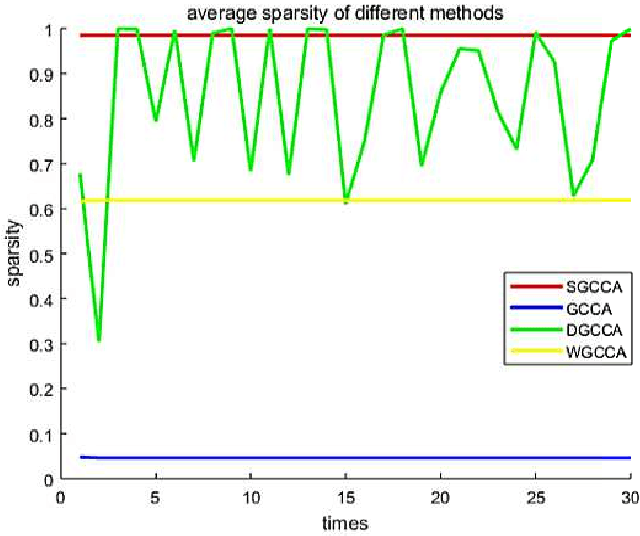

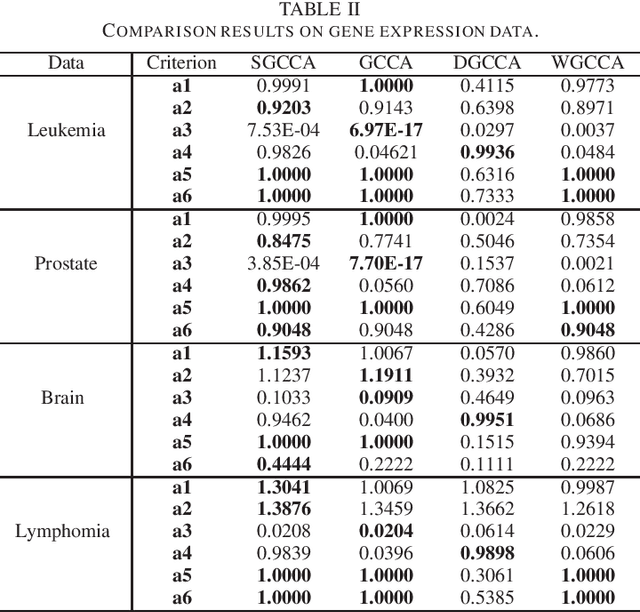

Abstract:Sparse canonical correlation analysis (CCA) is a useful statistical tool to detect latent information with sparse structures. However, sparse CCA works only for two datasets, i.e., there are only two views or two distinct objects. To overcome this limitation, in this paper, we propose a sparse generalized canonical correlation analysis (GCCA), which could detect the latent relations of multiview data with sparse structures. Moreover, the introduced sparsity could be considered as Laplace prior on the canonical variates. Specifically, we convert the GCCA into a linear system of equations and impose $\ell_1$ minimization penalty for sparsity pursuit. This results in a nonconvex problem on Stiefel manifold, which is difficult to solve. Motivated by Boyd's consensus problem, an algorithm based on distributed alternating iteration approach is developed and theoretical consistency analysis is investigated elaborately under mild conditions. Experiments on several synthetic and real world datasets demonstrate the effectiveness of the proposed algorithm.
Type I Attack for Generative Models
Mar 04, 2020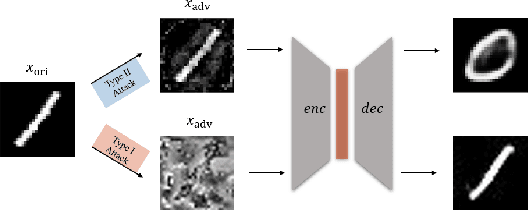

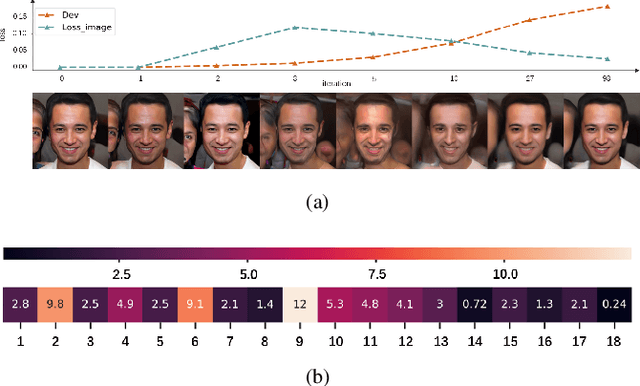
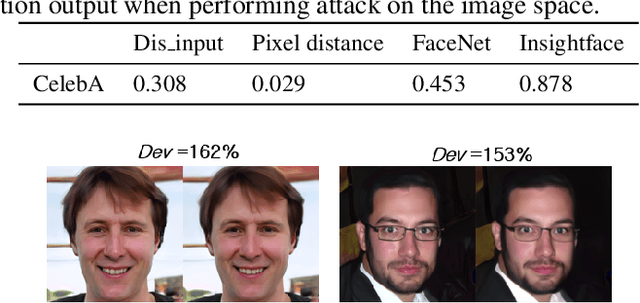
Abstract:Generative models are popular tools with a wide range of applications. Nevertheless, it is as vulnerable to adversarial samples as classifiers. The existing attack methods mainly focus on generating adversarial examples by adding imperceptible perturbations to input, which leads to wrong result. However, we focus on another aspect of attack, i.e., cheating models by significant changes. The former induces Type II error and the latter causes Type I error. In this paper, we propose Type I attack to generative models such as VAE and GAN. One example given in VAE is that we can change an original image significantly to a meaningless one but their reconstruction results are similar. To implement the Type I attack, we destroy the original one by increasing the distance in input space while keeping the output similar because different inputs may correspond to similar features for the property of deep neural network. Experimental results show that our attack method is effective to generate Type I adversarial examples for generative models on large-scale image datasets.
Generate High-Resolution Adversarial Samples by Identifying Effective Features
Jan 21, 2020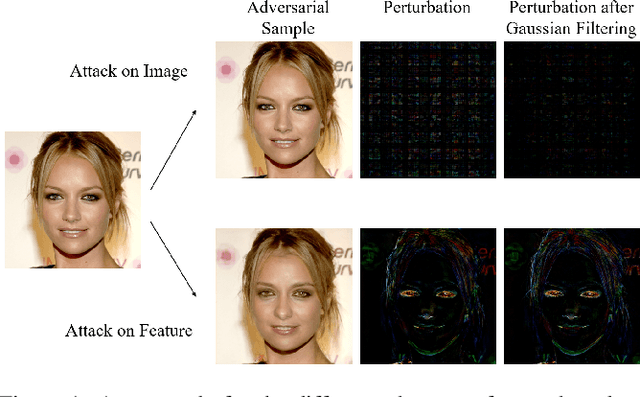
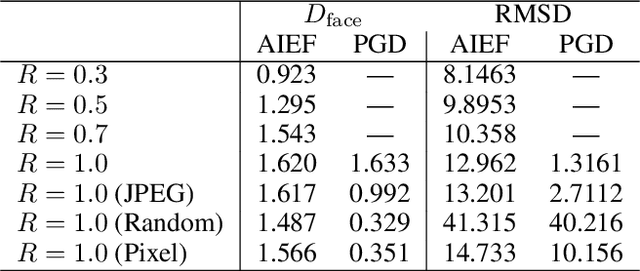
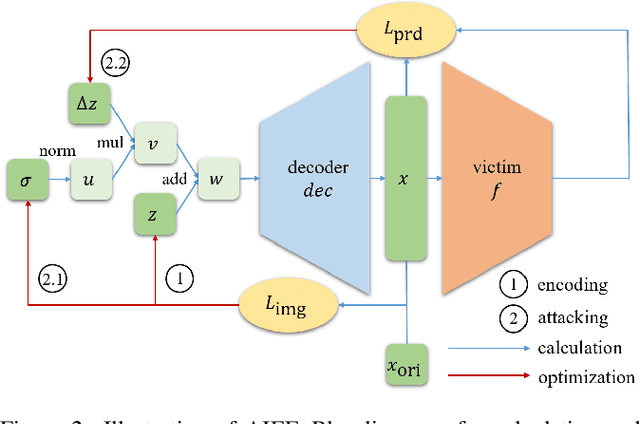
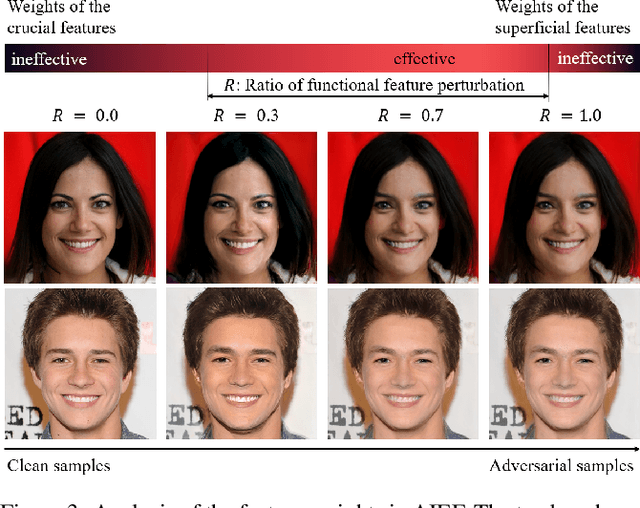
Abstract:As the prevalence of deep learning in computer vision, adversarial samples that weaken the neural networks emerge in large numbers, revealing their deep-rooted defects. Most adversarial attacks calculate an imperceptible perturbation in image space to fool the DNNs. In this strategy, the perturbation looks like noise and thus could be mitigated. Attacks in feature space produce semantic perturbation, but they could only deal with low resolution samples. The reason lies in the great number of coupled features to express a high-resolution image. In this paper, we propose Attack by Identifying Effective Features (AIEF), which learns different weights for features to attack. Effective features, those with great weights, influence the victim model much but distort the image little, and thus are more effective for attack. By attacking mostly on them, AIEF produces high resolution adversarial samples with acceptable distortions. We demonstrate the effectiveness of AIEF by attacking on different tasks with different generative models.
 Add to Chrome
Add to Chrome Add to Firefox
Add to Firefox Add to Edge
Add to Edge